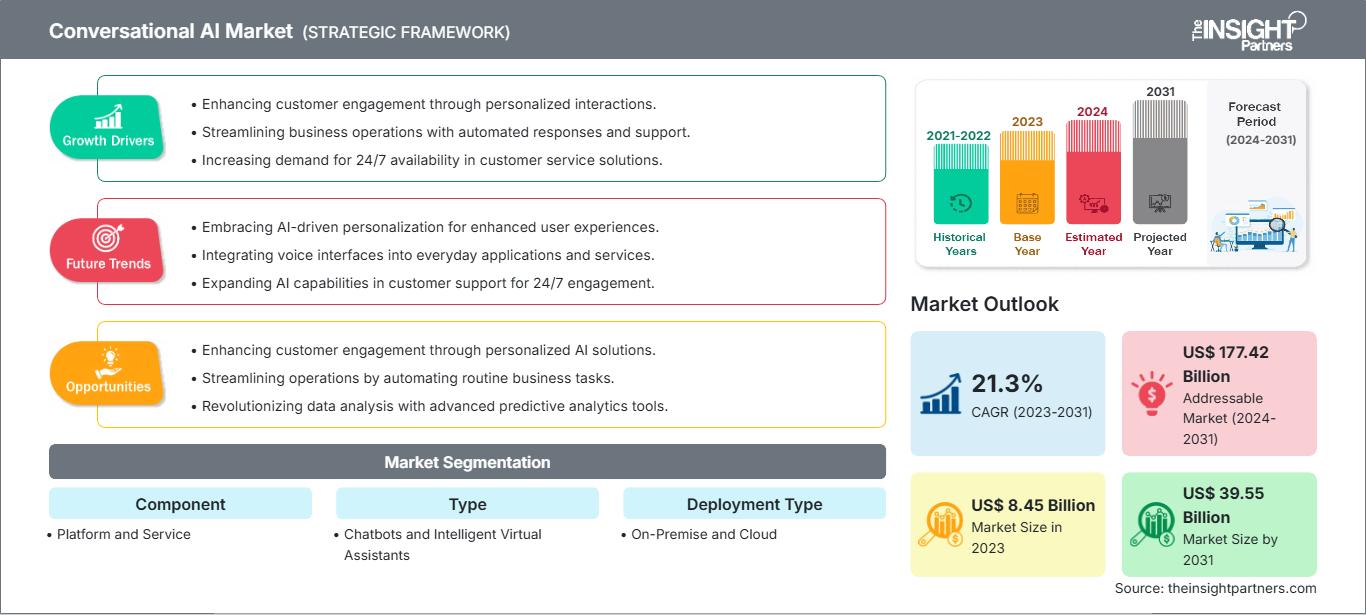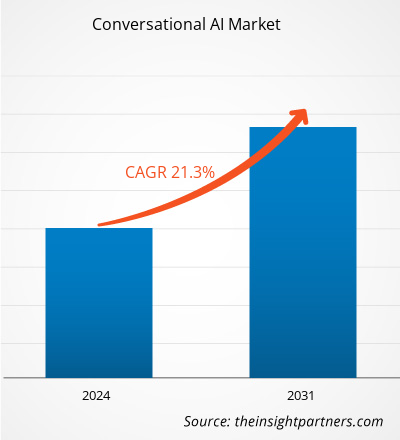Der Markt für Konversations-KI soll von 8,45 Milliarden US-Dollar im Jahr 2023 auf 39,55 Milliarden US-Dollar im Jahr 2031 anwachsen. Von 2023 bis 2031 wird ein durchschnittliches jährliches Wachstum (CAGR) von 21,3 % erwartet. Die zunehmende Verbreitung von Konversations-KI in der Spielebranche dürfte im Prognosezeitraum ein wichtiger Markttrend bleiben.
Marktanalyse für Konversations-KI
Die steigende Nachfrage und die sinkenden Kosten für die Entwicklung von Chatbots, KI-gestützter Kundensupport und Omnichannel-Bereitstellung treiben das Wachstum des Marktes für Konversations-KI voran. Zahlreiche Entwicklungsprojekte sind in Arbeit, um sicherzustellen, dass diese Technologien effektiv und effizient für Unternehmensanwendungsfälle eingesetzt werden, die echte Geschäftsprobleme lösen. Um die Fähigkeit der KI zu nutzen, gesprächsartig wie ein Mensch zu reagieren, sind zahlreiche Unternehmen für generative KI entstanden. KI hat das Potenzial, die Art und Weise, wie Menschen mit Technologie interagieren, völlig zu verändern, indem sie zwanglosere, menschenähnlichere Gespräche ermöglicht, die auf individuelle Bedürfnisse und Vorlieben zugeschnitten sind. Darüber hinaus erfreut sich der Einsatz von Conversational-AI-Plattformen in Organisationen des öffentlichen Sektors zunehmender Beliebtheit, da Regierungen weltweit an einer umfassenden digitalen Transformation arbeiten, das Bürgererlebnis neu erfinden und so das Marktwachstum ankurbeln.
Marktübersicht Conversational AI
Konversationelle künstliche Intelligenz (KI) bezeichnet Technologien, mit denen Verbraucher interagieren können, wie Chatbots oder virtuelle Agenten. Diese ahmen menschliche Interaktionen nach, indem sie Sprach- und Texteingaben erkennen, deren Bedeutung in mehrere Sprachen übersetzen und riesige Datenmengen, maschinelles Lernen (ML) und natürliche Sprachverarbeitung (NLP) nutzen. Conversational AI kombiniert NLP- und ML-Techniken mit traditionellen, statischen Arten interaktiver Technologien wie Chatbots. Durch Interaktionen, die denen mit herkömmlichen menschlichen Agenten ähneln, wird diese Kombination eingesetzt, um auf Verbraucher zu reagieren.
Passen Sie diesen Bericht Ihren Anforderungen an
Sie erhalten kostenlos Anpassungen an jedem Bericht, einschließlich Teilen dieses Berichts oder einer Analyse auf Länderebene, eines Excel-Datenpakets sowie tolle Angebote und Rabatte für Start-ups und Universitäten.
Markt für Konversations-KI: Strategische Einblicke

- Holen Sie sich die wichtigsten Markttrends aus diesem Bericht.Dieses KOSTENLOSE Beispiel umfasst Datenanalysen, die von Markttrends bis hin zu Schätzungen und Prognosen reichen.
Sie erhalten kostenlos Anpassungen an jedem Bericht, einschließlich Teilen dieses Berichts oder einer Analyse auf Länderebene, eines Excel-Datenpakets sowie tolle Angebote und Rabatte für Start-ups und Universitäten.
Markt für Konversations-KI: Strategische Einblicke

- Holen Sie sich die wichtigsten Markttrends aus diesem Bericht.Dieses KOSTENLOSE Beispiel umfasst Datenanalysen, die von Markttrends bis hin zu Schätzungen und Prognosen reichen.
Treiber und Chancen für den Markt für Konversations-KI
Wachsender E-Commerce-Sektor treibt den Markt für Konversations-KI an
Seit der COVID-19-Pandemie hat das Online-Shopping weltweit stark zugenommen. Laut der International Air Transport Association (IATA) kauften im Jahr 2021 2,14 Milliarden Menschen (d. h. 27,6 % der Weltbevölkerung) Produkte über Online-Portale. Darüber hinaus ist die Region Asien-Pazifik führend auf dem globalen E-Commerce-Markt, wobei China einen erheblichen Anteil am regionalen Marktwachstum ausmacht. Laut der International Trade Administration ist China der größte E-Commerce-Markt der Welt und generiert 50 % der weltweiten Transaktionen. Im Jahr 2021 erzielte das Land im E-Commerce-Sektor einen Umsatz von 1,5 Billionen US-Dollar und wurde damit zum größten E-Commerce-Markt der Welt. Auch Europa ist eine Schlüsselregion für das Wachstum des E-Commerce. Laut Eurostat nutzten im Jahr 2022 91 % der 16- bis 74-Jährigen in den Ländern der Europäischen Union (EU) das Internet, wobei etwa 75 % Waren oder Dienstleistungen online bestellten. Auch der Anteil der E-Shopper stieg von 55 % im Jahr 2012 auf 75 % im Jahr 2022, was einem Anstieg von 20 % im letzten Jahrzehnt entspricht. Viele Käufer in Europa bevorzugen Online-Shopping-Plattformen wie Amazon, Target und Walmart, die das Wachstum des E-Commerce-Sektors in Europa maßgeblich vorantreiben. Die wachsende Nachfrage nach Online-Shopping erhöht die Nachfrage nach Conversational Commerce. Die intelligenten, KI-gestützten Shopping-Bots revolutionieren die E-Commerce-Branche, indem sie mit ihren Kunden interagieren, personalisierte Beratung bieten und den Umsatz weiter steigern. Durch die Nutzung von maschinellem Lernen und natürlicher Sprachverarbeitung hilft Conversational AI außerdem dabei, sinnvolle Dialoge zu führen, Kundenbedürfnisse zu verstehen und Leads in Echtzeit zu pflegen. Somit treibt der wachsende E-Commerce-Sektor das Marktwachstum für Konversations-KI voran.
Aufkommen generativer KI bietet Marktchancen im Prognosezeitraum
Generative KI ist für zahlreiche Unternehmen äußerst wichtig. Ihre Fähigkeit, einzigartige Inhalte zu generieren, hat wichtige Auswirkungen auf Branchen wie Kunst, Design und Marketing. Diese Technologie verbessert die Personalisierung und erneuert und rationalisiert kreative Prozesse. Darüber hinaus unterstützt generative KI durch die Erstellung verschiedener Szenarien und Antworten die Problemlösung. Damit entwickelt sie sich zu einem wichtigen Werkzeug, das herkömmliche Methoden transformiert und neue Möglichkeiten eröffnet, während Branchen versuchen, das Potenzial KI-gesteuerter Innovationen auszuschöpfen. Darüber hinaus zeichnet sich generative KI durch die Automatisierung sich wiederholender Tätigkeiten aus und setzt so Personalressourcen für strategischere und komplexere Projekte frei. Darüber hinaus bietet sie hochgradig personalisierte Erlebnisse, indem sie Produktinformationen nach individuellem Geschmack bereitstellt. Von maßgeschneiderten Marketingkampagnen bis hin zu kuratierten Produktvorschlägen – die Technologie der generativen KI nutzt Daten, um Inhalte zu erstellen, die jeden Benutzer ansprechen. Die Integration generativer KI in Chatbots und virtuelle Assistenten verbessert deren Fähigkeit, an natürlichen, menschenähnlichen Gesprächen teilzunehmen. Diese Systeme interpretieren und verarbeiten Benutzereingaben, um Antworten, Vorschläge und Lösungen in Echtzeit zu generieren. Generative KI ermöglicht Chatbots, maßgeschneiderte Beratung zu liefern und schwierige Anfragen zu bearbeiten. Dies verändert den Kundenservice, E-Commerce-Interaktionen und andere Bereiche, in denen effektive Kommunikation entscheidend ist. Darüber hinaus verändert generative KI-Technologie die Welt der Sprachverarbeitung und ermöglicht präzise Übersetzungen und natürliche Interaktionen über traditionelle Kommunikationsgrenzen hinweg. Ihre Anwendungen in der Sprachübersetzung und Chatbot-Interaktion demonstrieren das revolutionäre Potenzial modernster KI-Technologie in zahlreichen Branchen. Daher wird erwartet, dass das Aufkommen generativer KI das Wachstum des Marktes für Konversations-KI im Prognosezeitraum ankurbeln wird.
Segmentierungsanalyse des Marktberichts für Konversations-KI
Schlüsselsegmente, die zur Ableitung der Marktanalyse für Konversations-KI beigetragen haben, sind Komponente, Typ, Bereitstellungstyp und Branche.
- Basierend auf der Komponente ist der Markt in Plattform und Service unterteilt. Das Plattformsegment dominierte den Markt im Jahr 2023.
- Basierend auf dem Typ ist der Markt in Chatbots und intelligente virtuelle Assistenten segmentiert. Das Chatbots-Segment dominierte den Markt im Jahr 2023.
- In Bezug auf den Bereitstellungstyp ist der Markt für Konversations-KI in On-Premise und Cloud segmentiert. Das On-Premise-Segment dominierte den Markt im Jahr 2023.
- Basierend auf der Branche ist der Markt in Einzelhandel & E-Commerce, Gesundheitswesen & Biowissenschaften, Reisen & Gastgewerbe, BFSI, IT & Telekommunikation, Medien & Unterhaltung und andere. Das Segment Einzelhandel & E-Commerce dominierte den Markt im Jahr 2023.
Analyse der Marktanteile von Konversations-KI nach Geografie
- Der Markt für Konversations-KI ist in fünf große Regionen segmentiert: Nordamerika, Europa, Asien-Pazifik (APAC), Naher Osten & Afrika (MEA) sowie Süd- & Mittelamerika. Nordamerika dominierte den Markt im Jahr 2023, gefolgt von Europa und APAC.
- Nordamerika hatte im Jahr 2023 den größten Marktanteil. Der Markt in der Region erlebt ein robustes Wachstum aufgrund der weit verbreiteten Einführung innovativer Technologien und des schnell steigenden Bedarfs an KI-gestützten Kundensupportdiensten. Darüber hinaus investiert die Mehrheit der Unternehmen in Nordamerika in technologische Innovationen, um die Bedürfnisse ihrer Kundschaft zu erfüllen und zu übertreffen. Das gestiegene Gesundheitsbewusstsein der Bevölkerung treibt ebenfalls das Wachstum des Marktes für Konversations-KI in der Region voran. Die Gesundheitsbranche in Nordamerika ist führend bei der Integration von Robotik, KI, virtueller Realität (VR) und erweiterter Realität (AR).
Konversations-KIRegionale Einblicke in den Markt für Konversations-KI
Die Analysten von The Insight Partners haben die regionalen Trends und Faktoren, die den Markt für Conversational AI im Prognosezeitraum beeinflussen, ausführlich erläutert. In diesem Abschnitt werden auch die Marktsegmente und die geografische Lage in Nordamerika, Europa, dem asiatisch-pazifischen Raum, dem Nahen Osten und Afrika sowie Süd- und Mittelamerika erörtert.
Umfang des Marktberichts zur Konversations-KI
| Berichtsattribut | Einzelheiten |
|---|---|
| Marktgröße in 2023 | US$ 8.45 Billion |
| Marktgröße nach 2031 | US$ 39.55 Billion |
| Globale CAGR (2023 - 2031) | 21.3% |
| Historische Daten | 2021-2022 |
| Prognosezeitraum | 2024-2031 |
| Abgedeckte Segmente |
By Komponente
|
| Abgedeckte Regionen und Länder | Nordamerika
|
| Marktführer und wichtige Unternehmensprofile |
|
Dichte der Marktteilnehmer im Bereich Conversational AI: Verständnis ihrer Auswirkungen auf die Geschäftsdynamik
Der Markt für Conversational AI wächst rasant, angetrieben durch die steigende Nachfrage der Endnutzer aufgrund von Faktoren wie sich entwickelnden Verbraucherpräferenzen, technologischem Fortschritt und einem stärkeren Bewusstsein für die Produktvorteile. Mit steigender Nachfrage erweitern Unternehmen ihr Angebot, entwickeln Innovationen, um den Bedürfnissen der Verbraucher gerecht zu werden, und nutzen neue Trends, was das Marktwachstum weiter ankurbelt.

- Holen Sie sich die Markt für Konversations-KI Übersicht der wichtigsten Akteure
Neuigkeiten und aktuelle Entwicklungen zum Markt für Konversations-KI
Der Markt für Konversations-KI wird durch die Erhebung qualitativer und quantitativer Daten nach Primär- und Sekundärforschung bewertet, die wichtige Unternehmenspublikationen, Verbandsdaten und Datenbanken umfasst. Einige der Entwicklungen auf dem Markt für Konversations-KI sind unten aufgeführt:
- Amazon.com, Inc. hat die allgemeine Verfügbarkeit von Amazon Q für Unternehmen und Entwickler angekündigt. Amazon Q ist der leistungsfähigste generative KI-gestützte Assistent zur Beschleunigung der Softwareentwicklung und Nutzung interner Unternehmensdaten.
(Quelle: Amazon, Pressemitteilung, April 2024)
- Wipro Limited hat die Wipro Enterprise Artificial Intelligence (AI)-Ready Platform eingeführt und nutzt dazu die watsonx-KI- und Datenplattformen von International Business Machines Corp., darunter watsonx.ai, watsonx.data und watsonx.governance, sowie KI-Assistenten. Diese Partnerschaft unterstützt Wipro Limited dabei, seinen Kunden einen interoperablen Service zu bieten, der die Einführung von KI beschleunigt.
(Quelle: International Business Machines Corporation, Pressemitteilung, Februar 2024)
Bericht zum Markt für Konversations-KI: Abdeckung und Ergebnisse
Der Bericht „Marktgröße und -prognose für Konversations-KI (2021–2031)“ bietet eine detaillierte Analyse des Marktes und deckt die unten genannten Bereiche ab:
- Marktgröße und -prognose für Kostenschätzungssoftware auf globaler, regionaler und Länderebene für alle abgedeckten wichtigen Marktsegmente
- Markttrends für Kostenschätzungssoftware sowie Marktdynamik wie Treiber, Einschränkungen und wichtige Chancen
- Detaillierte PEST- und SWOT-Analyse
- Marktanalyse für Kostenschätzungssoftware mit wichtigen Markttrends, globalen und regionalen Rahmenbedingungen, wichtigen Akteuren, Vorschriften und aktuellen Marktentwicklungen
- Branchenlandschaft und Wettbewerbsanalyse mit Marktkonzentration, Heatmap-Analyse, prominenten Akteure und aktuelle Entwicklungen im Markt für Konversations-KI
- Detaillierte Unternehmensprofile
- Historische Analyse (2 Jahre), Basisjahr, Prognose (7 Jahre) mit CAGR
- PEST- und SWOT-Analyse
- Marktgröße Wert/Volumen – Global, Regional, Land
- Branchen- und Wettbewerbslandschaft
- Excel-Datensatz
Aktuelle Berichte
Verwandte Berichte
Erfahrungsberichte
Grund zum Kauf
- Fundierte Entscheidungsfindung
- Marktdynamik verstehen
- Wettbewerbsanalyse
- Kundeneinblicke
- Marktprognosen
- Risikominimierung
- Strategische Planung
- Investitionsbegründung
- Identifizierung neuer Märkte
- Verbesserung von Marketingstrategien
- Steigerung der Betriebseffizienz
- Anpassung an regulatorische Trends




















 Kostenlose Probe anfordern für - Markt für Konversations-KI
Kostenlose Probe anfordern für - Markt für Konversations-KI